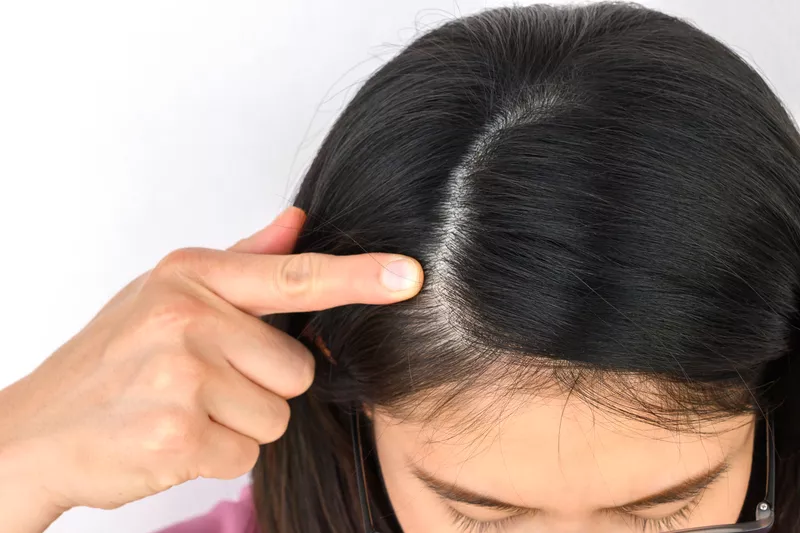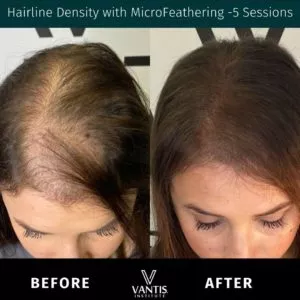“…hair breakage is a term used to describe the breakdown of an inner cuticle with overlapping scales that works to help the hair be bonded together.
“When the scales fall apart, the hairs become dry and separate from one another, which can result in split ends and shortened hair strands… if this type of damage isn’t addressed, it can lead to full-blown hair breakage where strands fall out altogether… When the hair is overprocessed, past its breaking point, the hair’s bonds can be easily damaged and become extremely dried out”
3 Ways Women Lose Hair (And How To Fix It)
Men aren’t the only ones who worry about losing hair. According to the Cleveland Clinic, it is estimated that over 30 million women in the United States alone will experience some form of hair loss in their lifetime.
And just like men, the effects of hair loss on women can be psychologically devastating:
“There is an important link between hair and identity, especially for women. About 40% of women with alopecia have had marital problems as a consequence, and about 63% claim to have had career related problems. The extent of alopecia is one of the predictors of psychological distress. People with severe hair loss are more likely to experience psychological distress.
…Most of the research shows that people with alopecia have higher levels of anxiety and depression than controls. They also experience lower self esteem, poorer quality of life, and poorer body image”
Every human being intuitively understands how hair loss can sabotage their life, which makes “accepting” it as the norm a very painful process that builds up self-hatred and brings down self-confidence.
To make matters more complicated, there are numerous ways that women can lose hair… meaning an experienced hair loss practitioner needs to know exactly what they are treating.
So here are three of the most common ways women experience hair loss (and what can be done to fix them), according to world-class non-surgical hair follicle restoration expert Jessica Olso.
Way #1: Hair Breakage
“Hair breakage” can be defined as hair loss due to chemical or physical damage done to the hair — think of heat, chemical processing, tight uhair styling, excessive brushing, drying hair improperly, dyes, and anything within that domain.
Andrew Fitzsimmons, a well-known celebrity hairstylist, describes the phenomenon in further detail:
Jessica has seen numerous women go down this route and they end up with most undesirable end result: Split ends, uneven length, hair never growing past a certain length, thinning hair, and an overall damaged appearance to the hair.
The good news is hair breakage is completely reversible and can be treated with both an adequate amount of time and the right products.
Websites such as Heathline and Carol’s Daugther are jam-packed with easy tips you can follow for free, if not a very low cost!
Way #2: Hair Loss From The Root
Also known as alopecia, this form of female hair loss takes on numerous forms and can arise from a long laundry list of underlying conditions:
“Alopecia can be divided into disorders in which the hair follicle is normal but the cycling of hair growth is abnormal and disorders in which the hair follicle is damaged. Androgenetic alopecia is the most common cause of hair loss in women. Other disorders include alopecia areata, telogen effluvium, cicatricial alopecia, and traumatic alopecias”
“…Every hair follicle continually goes through three phases: anagen (growth), catagen (involution, or a brief transition between growth and resting), and telogen (resting). Disorders of alopecia can be divided into those in which the hair follicle is normal but the cycling of hair growth is abnormal (e.g., telogen effluvium) and those in which the hair follicle is damaged (e.g., cicatricial alopecia).”
Here’s just a sample of the factors that female alopecia can be allocated to:
- Medications currently being taken
- Hormonal imbalances
- Genetic predisposition
- Existing health conditions
- Nutritional deficiencies
- Stress levels
This means you have to go through a lengthy and exhaustive process of elimination until you can narrow down the root cause of the type of alopecia a woman is suffering from.
But unlike men, women experience alopecia differently:
“In women, the hair loss is much more diffuse, rather than being centralized to the front or crown of the head. Hair tends to take on the appearance of thinning, rather than balding.
As they age, many women begin to notice a widening in their hair part because of this thinning. Very few women experience total baldness as a result of female pattern hair loss.”
Common treatments usually involve a variety of therapeutic solutions, with Minoxidil and Finasteride being the most common go-to choices. But for some cases, simply living a healthier lifestyle may be enough to reduce the likelihood (if not prevent) the onset of alopecia.
Jessica recognizes that these treatments have a time and place, but her preferred solution doesn’t involve the use of pharmaceutical drugs. You’ll see what she recommends to women at the end of this article. 😉
Way #3: Temple Hair Loss
If the picture above doesn’t paint a clear picture of what temple hair loss looks like, perhaps this simple description will clear things up:
“Your temples are the regions on the side of your head that is adjacent to your cheeks and eyes. It is above your ears and below your forehead. Your temples follow your hairline, so people with hair thinning in this area often notice their hairline recedes or thins out. Generally, women experience thinning in this region, whereas men encounter a recession of their hairline from their face.”
Put another way, the temples of the hairline can have fine baby hairs while the rest of the hair is nice and thick. This is more of an occurrence due to your genetics rather than hair loss, yet the discrepancy of fine baby hairs surrounded by thicker hair resembles hair loss and women feel as if their hair is receding.
Many women Jessica has treated report this type of hair loss results in making their forehead look larger, or are so self-conscious about it to the point where they avoid wearing their hair up in a pony tail.
Just like alopecia, temple hair loss has numerous underlying causes and therefore has many treatment options available that are similar to those available for alopecia.
However, some additional suggested treatments include injections and hair transplants.
How Women Can Immediately Fix Hair Loss
Women face a unique situation with hair loss because it’s extremely isolating. Not only does hair define femininity more than it does masculinity, but it’s not as common for women to start balding.
And since the hair loss is global instead of happening in a specific region of the scalp, they are often not eligible for hair transplant due to a lack of “donor hair”.
So what’s the solution for women who experience true alopecia and want to maintain the one thing that makes or breaks their physical appearance? And possibly their self-esteem?
Jessica Oslo spent eleven years perfecting a non-surgical solution called Vantis Follicle Replication (VFR) that helps women suffering from any form of hair loss. Her staff of experts are all certified in VFR and specifically.ly the challenges women face with balding.
Vantis Follicle Replication is a painless and non-invasive procedure done to immediately make a dramatic aesthetic change to give you a fuller thicker looking head of hair. It does not directly regrow hair, VFR makes it appear as if you have natural hair growth in the affected area.
The way it works is very simple:
“VFR mimics your own biological hair follicles by non-surgically inserting completely organic, plant-based pigment deposits through the dermal layer of the scalp. The pigment deposits perfectly replicate hair follicles and create an immediate appearance of a full head of hair.”
The visual problem is solved and clients report natural resorts can tell the difference regardless of how close-up they are to the treated person.
Jessica’s patients have the benefit of coming in to the Vantis clinic in beautiful Newport Beach California and receiving instant results after just one treatment. =
If you want to stop being ashamed of female hair loss and join thousands of women who no longer worry about thinning hair thanks to Vantis, here are 3 steps you can take right now:
- Visit Vantis hair loss clinic in Newport Beach, California and receive a Free Consultation with a Vantis hair loss expert.
- Call or text (949) 577-6531 to talk to a certified VFR expert practitioner now
- Receive a virtual consultation via Zoom, Facetime, WhatsApp, GoogleMeet or Skype to answer all of your questions and develop a personalized treatment plan to achieve your hair growth desired results. Schedule your FREE consultation here



